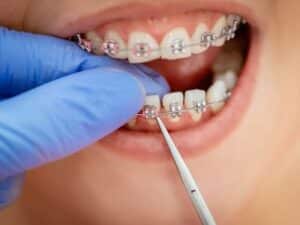More and more adults are using braces in Modesto, even though they may seem like something only teenagers get. In fact, the American Association of Orthodontists says that one out of every four orthodontic patients are adults.
If you’re the parent of a child who needs orthodontic treatment, you may be feeling overwhelmed by all the information out there. This will give you everything you need to know about comprehensive guide on braces, from what they are to how much they cost. We’ll also discuss how to find an affordable orthodontist in Modesto and what to expect during your child’s treatment.
Braces are used to correct flaws in the teeth and improve their alignment. We may move and straighten our teeth at any age, so braces are suitable for both children and adults who require to have their tooth position corrected. Adult patients desire fast and effective solutions with minimal pain, so they may be shocked to see how technology has advanced since they were kids.
Read on to find everything you need to know about braces and be surprised on how we thought this Orthodontic treatment for kids in Modesto can also suit you no matter your age!
What are Braces?
Let us first address this question, what are braces really and what is it for?
Braces are a type of orthodontic treatment that is used to correct dental problems like crooked or crowded teeth, overbites, underbites, and gaps between teeth. They work by applying pressure to the teeth and jawbone, which slowly moves the teeth into their proper position.
Braces can be extremely beneficial in treating dental conditions such as an uneven bite, which can cause jaw problems, or gaps between teeth that can affect gum health. This allows adults to keep their teeth in good shape for many years to come.
Your orthodontist will base the type of braces you need off the material it is made from, which ranges from metal – these are traditionally used – ceramic – clear braces – to plastic – Invisalign. The chosen material depends on how severe their dental problem is and what personal needs must be met.
Why Braces are applicable even for adults?
Though it may seem like your adult teeth are set in stone after they’ve come in, this isn’t the case. The pressure from chewing and constant pushing from your tongue gradually moves them until they become misaligned. This process can lead to gum inflammation as well as tiny, opened spaces for bacteria between gums which will then produce gum disease.
And it’s NOT just kids who want braces! Grown-ups sometimes get them for cosmetic reasons if they don’t like their smile.
What Are the Different Types of Braces?
Metal / Traditional Braces
Traditional braces include metal brackets that are placed onto the teeth and attached to a wire. The wires are often made of metal alloys, and they’re held together by tiny rubber bands. This style has been used for decades but has improved with the use of smaller, less noticeable brackets.
Ceramic Braces
Ceramic braces are like metal braces in that they have thin wires connecting the brackets. The brackets, on the other hand, are made of transparent ceramic or color-matched to the teeth. Because they’re less noticeable than metal braces, they’re generally somewhat more expensive. These types of braces are often a bit more comfortable than standard aligners and yet still cost somewhat more than metal aligners.
Invisalign
Invisalign, on the other hand, are clear plastic aligners that resemble mouth guards worn by people in sports. They’re made to measure and come as a single item rather than in separate parts, unlike conventional braces. Although retainers function similarly, aligners are meant to move teeth in tiny increments comparable to traditional braces.
Retainers, on the other hand, keep teeth in their proper positions. Retainers are usually worn for brief periods of time while aligners are designed to be worn for 22 hours a day and can be taken out during mealtime.
Self-Ligating Braces
Unlike traditional metal and ceramic braces which utilize rubber bands to secure brackets onto the wire, self-ligating braces have brackets that firmly clip right onto the wire. These types of braces are less noticeable because their brackets are smaller; they can even be clear.
If you’re constantly struggling with food getting stuck in your teeth while wearing braces, know that self-ligating ones significantly reduce this problem since there are no rubber bands for food to become trapped under. As a result, brushing and flossing is much easier too!
Lingual Braces
Lingual Braces are very much like traditional braces. The only difference is that these are attached at the back of your teeth.
Although lingual braces are less visible than traditional braces because the wires and brackets sit on the inner part of your teeth, they’re more challenging to keep clean. They can also be uncomfortable since they may initially cause tongue sores.
How Do Braces Work?
Braces work by gently shifting your teeth into the right position over time. This not only helps with gum health, but also benefits the actual tooth itself. Your teeth are made of four different types of dental tissue and when they’re aligned properly, it becomes more difficult for bacteria to form plaque and decay.
Braces gently guide teeth into a healthier arrangement as they are slowly withdrawn using little pressure—the type that gradually brought them out of alignment in the first place. This procedure is usually done over time, so your teeth may move freely and adapt. It has the potential to loosen your teeth and put them at risk if it’s done too rapidly.

Which Situations Are Braces Recommended?
To determine whether they are a suitable subject for orthodontic therapy, patients need to schedule a FREE consultation and go through a dental checkup. Pezoldt Orthodontics dentist examines the health of the gums as well as the general oral health of the teeth and mouth of the patient.
If you have advanced gum disease, tooth decay, or a lot of cavities, dentists and orthodontists will typically not recommend adult braces. If you need major dental operations like implants, this would certainly be the case. Braces wouldn’t be out of the question; however, these issues would first need to be addressed before they’re used.
Common reasons for getting braces, as reported by orthodontists, are an overbite, underbite, open bite, overcrowding (teeth too close together), and gaps between teeth – imagine your teeth as if they’re taking an exam. Additionally, misaligned teeth can cause problems with speech.
Conclusion
Braces are a great way to improve your smile and your overall oral health. If you think you may be a candidate for braces, schedule a free consultation today with Pezoldt Orthodontics. Our well-trained and equipped team of dentists are here to help you bring back your confident smile. We would be more than happy to help you get started on the path to straighter teeth!



 1 (209) 524-8381
1 (209) 524-8381 Modesto Office
Modesto Office